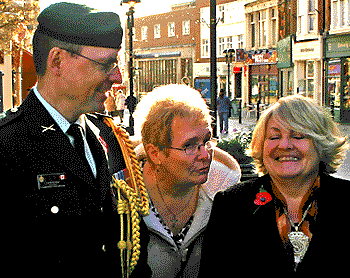Colonel Kevin Cotten, CD
The Canadian High Commission
 While
conducting research in preparation for today's ceremony, I
realised how woefully ignorant I was of the degree and the
extent of the carnage suffered by the people of Dover during the
Second World War. Turning to the modern-day version of the
encyclopaedia, the trusty internet, I was overwhelmed by the
accounts of terror and suffering endured by the Dovorian
civilians. I was particularly struck by a section of the Dover
War Memorial Project website. This section, dedicated to the
civilian casualties who died in Dover provides an alphabetized
list of those innocent civilians who succumbed to the ravages of
an enemy they could not even see. From Alfred and Martha Abbott,
aged 55 and 56, of Priory Gate Road, to Lena Amos, aged 20, who
died sheltering her infant daughter, 5-month-old Jean. From Emma
Odell, aged 86, of Adrian Street, to Arthur Young, aged 34, of
Endeavour Place. Man, Woman, Father, Mother, Son, Daughter,
Husband, Wife. The bombs and shells, for all their inherent
evil, did not discriminate in the selection of their victims.
While
conducting research in preparation for today's ceremony, I
realised how woefully ignorant I was of the degree and the
extent of the carnage suffered by the people of Dover during the
Second World War. Turning to the modern-day version of the
encyclopaedia, the trusty internet, I was overwhelmed by the
accounts of terror and suffering endured by the Dovorian
civilians. I was particularly struck by a section of the Dover
War Memorial Project website. This section, dedicated to the
civilian casualties who died in Dover provides an alphabetized
list of those innocent civilians who succumbed to the ravages of
an enemy they could not even see. From Alfred and Martha Abbott,
aged 55 and 56, of Priory Gate Road, to Lena Amos, aged 20, who
died sheltering her infant daughter, 5-month-old Jean. From Emma
Odell, aged 86, of Adrian Street, to Arthur Young, aged 34, of
Endeavour Place. Man, Woman, Father, Mother, Son, Daughter,
Husband, Wife. The bombs and shells, for all their inherent
evil, did not discriminate in the selection of their victims.
This ceremony is primarily about the many civilians who died in
their homes, in their workplaces, on their roads, and in the
casualty hospital. But it is also about the gallant efforts of
other nations, whose civilians turned soldiers took up arms to
fight against a common enemy. Among them were over 12.1 million
Canadians who served in the army, navy, and air force; over
1000, 000 were either killed or wounded, but they accomplished
numerous acts of heroism, and contributed to a victory over a
fearsome and determined enemy.
From the perspective of the people of Dover, there was no more
valiant a victory than the day in September 1944 that elements
of the 1st Canadian Army silenced the dreaded guns surrounding
Calais. I thought I would take a moment to describe this action
in the words of a participant, who lived it first hand. 2nd
Lieutenant James Wareing, a British armoured officer of the
141st RAC (also known as the Buffs) which belonged to 79th
Armoured Division, which at the time was under command of the
1st Canadian Army. I will let "2nd Lieutenant Wareing's words
speak for themselves.
(Colonel Cotten then read the story of 2nd Lieutenant James
Wareing, from the BBC's World War II People's War series. It may
be seen
here
)
As 2nd Lieutenant Wareing points out, the guns were finally
silenced and if this provided cause for celebration amongst
 the troops of the 1st Canadian Army, I can only imagine the
jubilance of the Dovorians. News of this victory flashed across
the Atlantic and congratulatory messages came from far and wide,
including this one from the Mayor of Toronto, Canada. "In the
name of the citizens of Toronto, Canada, I extend
congratulations to the people of Dover on the cessation of
shelling from enemy held ports across the channel. It will be a
great relief to your people to be no longer under the necessity
of living in caves. The fortitude and courage of the citizens of
Dover in the face of enemy attacks has won our admiration. our
prayers and best wishes are yours."
the troops of the 1st Canadian Army, I can only imagine the
jubilance of the Dovorians. News of this victory flashed across
the Atlantic and congratulatory messages came from far and wide,
including this one from the Mayor of Toronto, Canada. "In the
name of the citizens of Toronto, Canada, I extend
congratulations to the people of Dover on the cessation of
shelling from enemy held ports across the channel. It will be a
great relief to your people to be no longer under the necessity
of living in caves. The fortitude and courage of the citizens of
Dover in the face of enemy attacks has won our admiration. our
prayers and best wishes are yours."
I would like to think that the fortitude and courage of the
citizens of Dover brought out these same attributes in the
Canadian soldiers, sailors, and airmen who played such a large
part in winning the war.
In closing I recount these verses from Rudyard Kipling's "Two
Canadian Memorials."
From little towns, in a far land, we came,
To save our honour and a world aflame;
By little towns, in a far land, we sleep,
And trust those things we won to you to keep.
photo: Michael Munn
above, part of the telegram from Fred J Conboy, Mayor of Toronto
previous speech - next speech